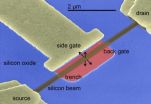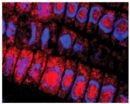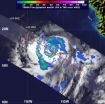(Press-News.org) "There is not enough radio spectrum to account for everybody's handheld portable device," said Jeffrey Rhoads, an associate professor of mechanical engineering at Purdue University.
The overcrowding results in dropped calls, busy signals, degraded call quality and slower downloads. To counter the problem, industry is trying to build systems that operate with more sharply defined channels so that more of them can fit within the available bandwidth.
"To do that you need more precise filters for cell phones and other radio devices, systems that reject noise and allow signals only near a given frequency to pass," said Saeed Mohammadi, an associate professor of electrical and computer engineering who is working with Rhoads, doctoral student Hossein Pajouhi and other researchers.
The Purdue team has created devices called nanoelectromechanical resonators, which contain a tiny beam of silicon that vibrates when voltage is applied. Researchers have shown that the new devices are produced with a nearly 100 percent yield, meaning nearly all of the devices created on silicon wafers were found to function properly.
"We are not inventing a new technology, we are making them using a process that's amenable to large-scale fabrication, which overcomes one of the biggest obstacles to the widespread commercial use of these devices," Rhoads said.
Findings are detailed in a research paper appearing online in the journal IEEE Transactions on Nanotechnology. The paper was written by doctoral students Lin Yu and Pajouhi, Rhoads, Mohammadi and graduate student Molly Nelis.
In addition to their use as future cell phone filters, such nanoresonators also could be used for advanced chemical and biological sensors in medical and homeland-defense applications and possibly as components in computers and electronics.
The devices are created using silicon-on-insulator, or SOI, fabrication -- the same method used by industry to manufacture other electronic devices. Because SOI is compatible with complementary metal–oxide–semiconductor technology, or CMOS, another mainstay of electronics manufacturing used to manufacture computer chips, the resonators can be readily integrated into electronic circuits and systems.
The resonators are in a class of devices called nanoelectromechanical systems, or NEMS.
The new device is said to be "highly tunable," which means it could enable researchers to overcome manufacturing inconsistencies that are common in nanoscale devices.
"Because of manufacturing differences, no two nanoscale devices perform the same rolling off of the assembly line," Rhoads said. "You must be able to tune them after processing, which we can do with these devices."
The heart of the device is a silicon beam attached at two ends. The beam is about two microns long and 130 nanometers wide, or about 1,000 times thinner than a human hair. The beam vibrates in the center like a jump rope. Applying alternating current to the beam causes it to selectively vibrate side-to-side or up and down and also allows the beam to be finely adjusted, or tuned.
The nanoresonators were shown to control their vibration frequencies better than other resonators. The devices might replace electronic parts to achieve higher performance and lower power consumption.
"A vivid example is a tunable filter," Mohammadi said. "It is very difficult to make a good tunable filter with transistors, inductors, and other electronic components, but a simple nanomechanical resonator can do the job with much better performance and at a fraction of the power."
Not only are they more efficient than their electronic counterparts, he said, but they also are more compact.
"Because the devices are tiny and the fabrication has almost a 100 percent yield, we can pack millions of these devices in a small chip if we need to," Mohammadi said. "It's too early to know exactly how these will find application in computing, but since we can make these tiny mechanical devices as easily as transistors, we should be able to mix and match them with each other and also with transistors in order to achieve specific functions. Not only can you put them side-by-side with standard computer and electronic chips, but they tend to work with near 100 percent reliability."
The new resonators could provide higher performance than previous MEMS, or microelectromechanical systems.
In sensing application, the design enables researchers to precisely measure the frequency of the vibrating beam, which changes when a particle lands on it. Analyzing this frequency change, allows researchers to measure minute masses. Similar sensors are now used to research fundamental scientific questions. However, recent advances may allow for reliable sensing with portable devices, opening up a range of potential applications, Rhoads said.
Such sensors have promise in detecting and measuring constituents such as certain proteins or DNA for biological testing in liquids, gases and the air, and the NEMS might find applications in breath analyzers, industrial and food processing, national security and defense, and food and water quality monitoring.
"The smaller your system the smaller the mass you can measure," Rhoads said. "Most of the field-deployable sensors we've seen in the past have been based on microscale technologies, so this would be hundreds or thousands of times smaller, meaning we should eventually be able to measure things that much smaller."
INFORMATION:
The work is based at the Dynamic Analysis of Micro- and Nanosystems Laboratory at the Birck Nanotechnology Center in Purdue's Discovery Park. Other faculty members and graduate students also use the specialized facility.
The researchers have filed a patent application for the concept. The research is funded by the National Science Foundation.
Writer: Emil Venere, 765-494-4709, venere@purdue.edu
Source: Jeffrey Rhoads, 765-494-5630, jfrhoads@purdue.edu
Saeed Mohammadi, 765-494-3557, saeedm@purdue.edu
Related Web site:
Jeffrey Rhoads: https://engineering.purdue.edu/ME/People/ptProfile?id=34218
Saeed Mohammadi: https://engineering.purdue.edu/ECE/People/profile?resource_id=3246
PHOTO CAPTION:
This image from a scanning electron microscope shows a tiny mechanical device, an electrostatically-actuated nanoresonator, that might ease congestion over the airwaves to improve the performance of cell phones and other portable devices. (Purdue University image)
A publication-quality photo is available at http://news.uns.purdue.edu/images/+2009/rhoads-nems.jpg
ABSTRACT
Tunable, Dual-Gate, Silicon-on-Insulator (SOI) Nanoelectromechanical Resonators
Lin Yu, Hossein Pajouhi, Molly R. Nelis, Jeffrey F. Rhoads, and Saeed Mohammadi, Senior Member, IEEE
Resonant nanoelectromechanical systems (NEMS) have the potential to have significant impact in mass sensing, signal processing and field detection applications, if the challenges associated with processing, material and geometric variability can be mitigated. The research presented here details a breakthrough in the design and development of resonant NEMS aimed at addressing these challenges. Specifically, the work details the fabrication, characterization, and tuning of dual-gate silicon nanoelectromechanical resonators, which are transduced electrostatically and realized with close to 100% yield. These devices are fabricated on a silicon-on-insulator (SOI) substrate using only top-down microfabrication techniques and can be easily integrated with SOI-CMOS transistors, enabling the development of fully integrated CMOS-NEMS with highly-tunable nonlinear frequency response characteristics.
'Nanoresonators' might improve cell phone performance
2012-08-31
ELSE PRESS RELEASES FROM THIS DATE:
Discovery may help protect crops from stressors
2012-08-31
VIDEO:
Scientists at the Salk Institute for Biological Studies have discovered a key genetic switch by which plants control their response to ethylene gas, a natural plant hormone best known for...
Click here for more information.
LA JOLLA, CA----Scientists at the Salk Institute for Biological Studies have discovered a key genetic switch by which plants control their response to ethylene gas, a natural plant hormone best known for its ability to ripen fruit, but which, under ...
Biophysicists unravel secrets of genetic switch
2012-08-31
When an invading bacterium or virus starts rummaging through the contents of a cell nucleus, using proteins like tiny hands to rearrange the host's DNA strands, it can alter the host's biological course. The invading proteins use specific binding, firmly grabbing onto particular sequences of DNA, to bend, kink and twist the DNA strands. The invaders also use non-specific binding to grasp any part of a DNA strand, but these seemingly random bonds are weak.
Emory University biophysicists have experimentally demonstrated, for the fist time, how the nonspecific binding of ...
NASA spotted hot towers in Ileana that indicated its increase to hurricane status
2012-08-31
Hot Towers are towering clouds that emit a tremendous amount of latent heat (thus, called "hot"). NASA research indicates that whenever a hot tower is spotted, a tropical cyclone will likely intensify. Less than 14 hours after the TRMM satellite captured an image of Ileana's rainfall and cloud heights, Ileana strengthened into a hurricane on Aug. 29.
NASA's Tropical Rainfall Measuring Mission (TRMM) satellite captured a view of Ileana's rainfall rates on Aug. 29 at 2:17 a.m. EDT and saw the heaviest rainfall rates, near 50 mm (2.0 inches) per hour in a band of thunderstorms ...
NASA sees Tropical Storm Tembin make landfall in South Korea
2012-08-31
Tropical Storm Tembin made landfall in the in southwestern South Korea and NASA's Aqua satellite captured the extent of the storm's elongated cloud cover, revealing the effect of wind shear on the storm.
Tembin moved through the Myeongnyang Strait and made landfall on Aug. 30, 2012 at 0000 UTC (Aug. 29 at 8 p.m. EDT) in the southwestern tip of South Korea.
NASA's Aqua satellite's Moderate Resolution Imaging Spectroradiometer (MODIS) instrument captured a visible, true-color image of Tropical Storm Tembin around the time of landfall in southwestern South Korea. The image ...
NASA spies fifth Atlantic hurricane and twelfth tropical depression
2012-08-31
Tropical Storm Kirk intensified into a hurricane today, Aug. 30, while another tropical depression was born. Satellite imagery revealed Hurricane Kirk and newborn Tropical Depression 12 romping through the central Atlantic Ocean today, while Tropical Storm Isaac continues to drench the U.S. Gulf coast and Mississippi Valley. Kirk became the Atlantic Ocean season's fifth hurricane today, Aug. 30.
On Aug. 30 at 7:45 a.m. EDT, a visible image from NOAA's GOES-13 satellite captured all three tropical cyclones in a panoramic shot of the Atlantic Ocean basin. The visible image ...
Rice, MD Anderson scientists probe mystery of operon evolution
2012-08-31
HOUSTON -- (Aug. 30, 2012) -- The threads of an evolutionary mystery that dates to the birth of molecular biology are beginning to unravel, thanks to a new investigation by computational bioengineers at Rice University and the University of Texas MD Anderson Cancer Center.
In new research published online this week in PLOS Computational Biology, Rice's Oleg Igoshin and MD Anderson's Christian Ray offer a possible explanation for the existence of jointly controlled clusters of genes called operons, which are found in bacterial chromosomes but not in those of higher order ...
Traumatic childhood may increase the risk of drug addiction
2012-08-31
Previous research has shown that personality traits such as impulsivity or compulsiveness are indicators of an increased risk of addiction. Now, new research from the University of Cambridge suggests that these impulsive and compulsive personality traits are also associated with a traumatic upbringing during childhood. The study was published today, 31 August, in the journal American Journal Psychiatry.
Led by Dr Karen Ersche, the Cambridge researchers aimed to identify risk factors that make a person vulnerable to developing drug dependence. They examined 50 adults ...
Lilburn, GA Accident Injury Chiropractor Helps Locals Get Relief from Whiplash Pain
2012-08-31
Dr. Matthew Loop, whose busy chiropractic office is located in Lilburn GA, uses a combination of approaches to help relieve the discomfort and stress associated with back pain. His approach includes chiropractic, soft tissue therapy and rehabilitation services. This combination offers patients quick relief.
"The problem with auto injuries," says Dr. Loop, "is that they can manifest themselves in so many different ways, making pain management for the patient very difficult. Some patients suffer from generalized pain that is combined with pain located in ...
The Art of Living Foundation Announces The Launch Of Take A Breath, Seattle! An Initiative to Recharge People in Seattle
2012-08-31
The Art of Living Foundation announced today that it has launched Take a Breath, Seattle, an initiative to help Seattleites recharge and do more of the things they love through the powerful benefits of breath.
Take a Breath, Seattle, is an ambitious initiative that aims to increase awareness about the powerful benefits of breath as a practical tool to combat stress.
The Seattle metro continues to be home for an active, health-conscious population - many of who work under high pressure to deliver in an intensely competitive environment, often leaving them stressed ...
Sonic Emotion Absolute 3D Sound Technology Integrated in Toshiba 3D Sound Bar Devices
2012-08-31
Sonic Emotion, the developer of Absolute 3D sound announced today that its Absolute 3D sound technology will be integrated in Toshiba's Mini 3D Sound Bar with Subwoofer SBM1W and 3D Sound Bar SB1 - SBK1. Both sound systems, featuring Sonic Emotion's Absolute 3D sound technology, provide users a nontraditional, multipurpose performance system that elicits optimum sound quality and creates the ultimate 3D listening experience. Toshiba's Mini 3D Sound Bar with Subwoofer SBM1W and 3D Sound Bar SB1 - SBK1 will be available in select regions in the fourth quarter of 2012.
"We ...





